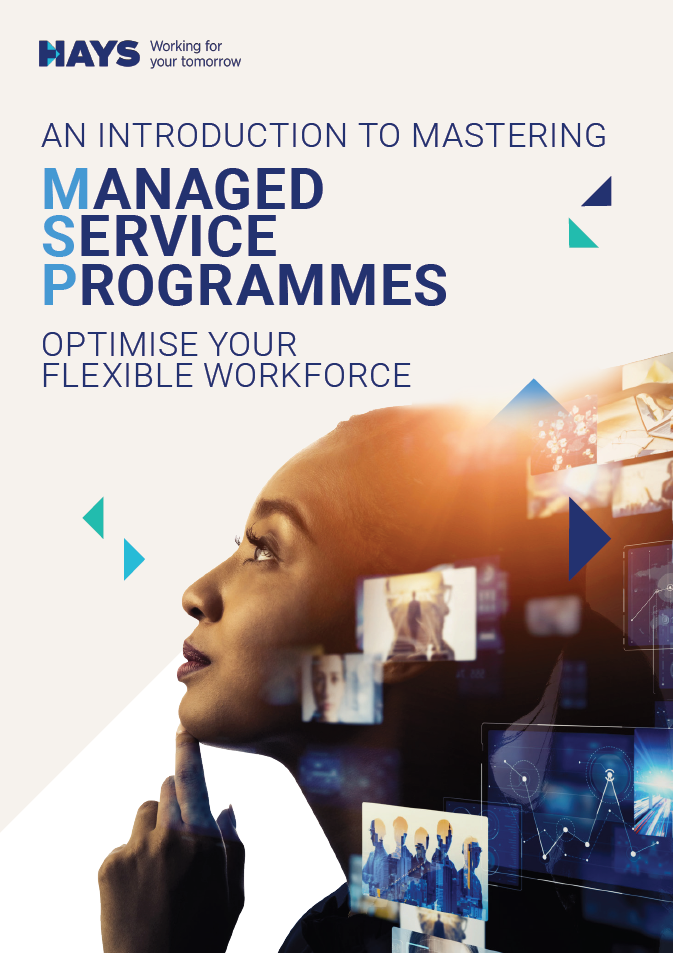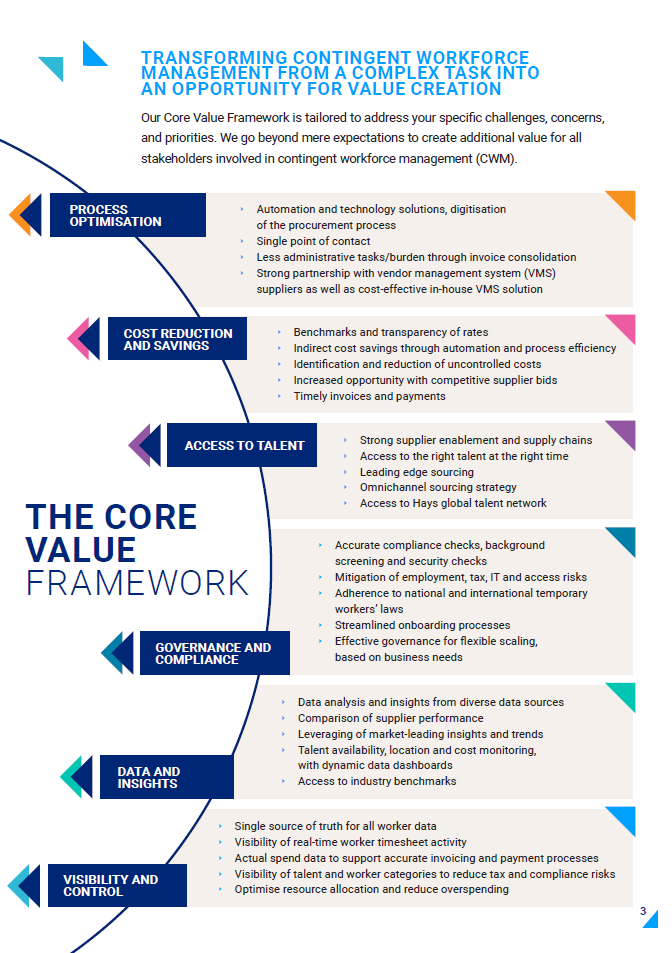
Managed Service
Programme (MSP)
Alt-i-én løsning
for din fleksible arbejdskraft
Freelancere, selvstændige, uafhængige konsulenter, vikarer eller gig-workers. Tilgangen til fleksibel arbejdskraft ændrer sig og de er ikke længere bare et midlertidigt alternativ til fastansatte. I stedet er brugen af freelancere og vikarer hurtigt ved at blive en håndgribelig strategi for mange organisationer – og i takt med at efterspørgslen efter fleksible, skalerbare talentløsninger vokser, leder mange organisationer efter en måde at kontrollere kaosset på.
Vores Managed Service Programme (MSP) repræsenterer den næste generation af workforce løsninger – vi sikrer velorganiseret og effektiv håndtering af dit eksterne personale og konsulenter, samt leverandører hertil, ved at digitalisere og automatisere hele din procurement, interview og onboardingproces. Vores fokus er at gøre det muligt for din organisation at gentænke jeres talent supply chain, for at kunne levere det rette talent, på det rette tidspunkt og til den rette pris. Alt imens vi leverer den risikoreduktion, administrative aflastning og resultatstyring, som du normalt ville forvente fra en traditionel Managed Service leverandør.
Vores Managed Service Programme (MSP) repræsenterer den næste generation af workforce løsninger – vi sikrer velorganiseret og effektiv håndtering af dit eksterne personale og konsulenter, samt leverandører hertil, ved at digitalisere og automatisere hele din procurement, interview og onboardingproces. Vores fokus er at gøre det muligt for din organisation at gentænke jeres talent supply chain, for at kunne levere det rette talent, på det rette tidspunkt og til den rette pris. Alt imens vi leverer den risikoreduktion, administrative aflastning og resultatstyring, som du normalt ville forvente fra en traditionel Managed Service leverandør.
Indhold
Vil du snakke med en konsulent?
44%
af ledere siger, at de har svært ved at finde fleksibel arbejdskraft med specifikke kompetencer
Kun 35%
af ledere siger de bruger teknologi til at administrere deres fleksible arbejdskraft
*Agile Procurement Insights Research af SAP i samarbejde med Oxford Economics, 2021
Hvad er en MSP?
Et Managed Service Programme (MSP) er en løsning, der hjælper virksomheder med effektivt at administrere og optimere deres fleksible arbejdsstyrke – en ofte kærkommen administrativ aflastning.
Kort sagt overtager en MSP-udbyder den komplekse proces med at finde, interviewe, ansætte, administrere og sikre, at vikarer og freelancere bliver betalt til tiden. Samtidig sikrer de juridisk compliance og leverer detaljeret rapportering af resultater – og muligheder for forbedringer.
Kort sagt overtager en MSP-udbyder den komplekse proces med at finde, interviewe, ansætte, administrere og sikre, at vikarer og freelancere bliver betalt til tiden. Samtidig sikrer de juridisk compliance og leverer detaljeret rapportering af resultater – og muligheder for forbedringer.
Hvad er VMS?
Kernen i en MSP er Vendor Management System (VMS) – en softwareplatform, der håndterer alt fra tracking af nye projektstillinger til håndtering af tid og fakturaer. Et VMS er altså MSP'ens digitale rygrad og hjælper dig med at bevare kontrol, transparens og overblik over din fleksible arbejdsstyrke.
Hvordan er det anderledes end en Preferred Supplier?
En MSP er den holistiske løsning. Den tilbyder en end-to-end-administration af hele din fleksible arbejdsstyrke, herunder interaktion med andre leverandører og bureauer, der leverer freelancere, konsulenter og vikarer.
MSP'en fungerer altså som en mellemmand, der sikrer en pålidelig kommunikationsstrøm og sørger for, at alle leverandører lever op til din organisations standarder og krav. Samtidig sikrer MSPen, at din adgang til specialister og de rette kompetencer ikke er begrænset af bureauets loyalitet eller kontrakter.
MSP'en fungerer altså som en mellemmand, der sikrer en pålidelig kommunikationsstrøm og sørger for, at alle leverandører lever op til din organisations standarder og krav. Samtidig sikrer MSPen, at din adgang til specialister og de rette kompetencer ikke er begrænset af bureauets loyalitet eller kontrakter.
Hvordan kan min virksomhed spare penge med en MSP?
De reelle omkostninger til freelancere, konsulenter og vikarer er sjældent særligt transparante, hvilket fører til, at budgetterne ofte overskrides, uden at nogen opdager det. For udgifterne til fleksibel arbejdskraft håndteres som regel i de enkelte afdelinger, og gør det dermed svært at se det fulde økonomiske billede.
Og det er her, en MSP virkelig kan hjælpe. Din MSP-partner udnytter store mængder data til at spore og analysere omkostninger ved din fleksible arbejdskraft, leverandørers performance og compliance. Og ved at forhandle bedre priser gennem stordrift, holde nøje øje med leverandørernes resultater og sikre gennemsigtighed i kontraktomkostningerne kan en MSP afdække områder, hvor der kan spares og optimeres.
Derudover er 91 % af MSP'erne overvejende leverandørfinansierede*. Kort sagt betyder det, at det administrationsgebyr, der skal betales til din MSP-partner (f.eks. Hays), absorberes af underleverandørerne gennem genforhandling af priser og gebyrer.
Og det er her, en MSP virkelig kan hjælpe. Din MSP-partner udnytter store mængder data til at spore og analysere omkostninger ved din fleksible arbejdskraft, leverandørers performance og compliance. Og ved at forhandle bedre priser gennem stordrift, holde nøje øje med leverandørernes resultater og sikre gennemsigtighed i kontraktomkostningerne kan en MSP afdække områder, hvor der kan spares og optimeres.
Derudover er 91 % af MSP'erne overvejende leverandørfinansierede*. Kort sagt betyder det, at det administrationsgebyr, der skal betales til din MSP-partner (f.eks. Hays), absorberes af underleverandørerne gennem genforhandling af priser og gebyrer.
*Undersøgelse foretaget af SIA (Staffing Industry Analysts)
De forskellige typer af MSPer

Master Vendor
Din MSP-partner forsyner dig med det meste af din fleksible arbejdskraft, og bruger kun andre bureauer og leverandører hvis nødvendigt. Gør det muligt for din partner at få en bedre forståelse af dine behov og dine udgifter er mere forudsigelige.

Neutral Vendor
Alle dine leverandører får mulighed for at byde ind på ledige stillinger på lige fod og din MSP-partner kontrollerer forsyningskæden. Modellen lægger op til mere konkurrencedygtige priser, men omvendt kan for meget konkurrence også betyde at nogle leverandører ikke vil bruge ressourcer på at byde ind.

Hybrid Model
Best of both worlds. Din MSP-partner finder selv konsulenter til projekter og stillinger til din kerneforretning, mens de måske bruger andre leverandører til roller de ikke selv har et stort netværk indenfor eller viden om. Særligt god løsning for global MSPer.
Overvejer I hvorvidt det er tid til at ændre på, hvordan jeres organisation tilgår jeres midlertidige arbejdsstyrke? Hvis du allerede kæmper med problemer som stigende omkostninger, compliance eller manglende overblik over dine arbejdsstyrkedata, bør svaret være »ja«. Men er et Managed Service Programme den rigtige løsning for jer? Og hvis ja, hvordan sikrer I så opbakning fra jeres vigtigste interessenter?
Tegn på, at det er tid til forandring

Forskellige tilgange & compliance problemer
Er det op til de enkelte afdelinger, hvordan de administrerer indkøb og brug af freelancers og vikarer? Inkonsistens kan lede til personalejuridiske udfordringer, da der er særlige forhold som regulerer hvorvidt der er tale om en freelancekontrakt eller et ansættelsesforhold.

Ukontrollerede omkostninger
Fraværet af en struktureret liste over foretrukne leverandører (Preferred Supplier List/PSL) i en fragmenteret forsyningskæde kan hurtigt lede til større og uigennemskuelige omkostningsoverskridelser. Problemet bliver ofte forværret af ad-hoc tilføjelser af nye leverandører.

Leverandørkaos
Har I mange leverandører og intet reelt overblik over hvilke afdelinger der gør brug af dem? En ustruktureret tilgang leder ofte til faktureringsproblemer, manglende købsordrer, forsinkede betalinger til freelancers og et forhøjet administrativt arbejde.
Og i så fald oplever I sandsynligvis også at manuelle processer og forskellige metoder til at registrere omkostninger ved jeres midlertidige arbejdsstyrke hindrer nøjagtig rapportering og dataoverblik.
Og i så fald oplever I sandsynligvis også at manuelle processer og forskellige metoder til at registrere omkostninger ved jeres midlertidige arbejdsstyrke hindrer nøjagtig rapportering og dataoverblik.

Begrænset data & indsigt
Grundet brugen af mange leverandører og forskellige faktureringssystemer, så oplever mange virksomheder ofte at de ikke har et transparent datagrundlag eller indsigt i den overordnede status på deres midlertidige arbejdsstyrke – kan I fx svare på hvor mange freelancere der pt. er I jeres virksomhed? Hvor længe er de gennemsnitligt tilknyttet? Hvor mange bliver betalt rettidigt?
Når I gør brug af flere systemer og processer, vil det ofte lede til en større administrativ byrde, men også fejl og øgede omkostninger.
Når I gør brug af flere systemer og processer, vil det ofte lede til en større administrativ byrde, men også fejl og øgede omkostninger.

Udfordringer med indkøb og talenttiltrækning
Har I svært ved at finde freelancers, konsulenter og vikarer med de rette kompetencer? Den nok største fordel ved brugen af fleksibel arbejdskraft er, at du kan få de rette færdigheder her-og-nu i en plug-and-play løsning.
Hvis dine nuværende leverandører har svært ved at finde de rette freelancers eller ikke kan sælge din virksomhed til dem, så er det måske et tegn på at de ikke kender jer godt nok – og dermed ikke formår at skræddersy deres kommunikation til din målgruppe.
Hvis dine nuværende leverandører har svært ved at finde de rette freelancers eller ikke kan sælge din virksomhed til dem, så er det måske et tegn på at de ikke kender jer godt nok – og dermed ikke formår at skræddersy deres kommunikation til din målgruppe.

Er en MSP løsningen på jeres problemer?
Når I har identificeret tegnene på, at I har brug for en forandring, så er næste skridt at vurdere hvorvidt en MSP passer til din organisations behov – eller om en optimering af interne processer og en oprydning i leverandørlisten er nok.
Nøglen her er at forstå både omfanget og kompleksiteten af din fleksible arbejdsstyrke, og hvor hurtigt den skal kunne omstilles.
Nøglen her er at forstå både omfanget og kompleksiteten af din fleksible arbejdsstyrke, og hvor hurtigt den skal kunne omstilles.

Omfang & kompleksitet
Hvor mange freelancere og vikarer har I? Hvor bor de? Er de på korte eller lange kontrakter, eller en blanding af begge dele? Jo større og mere kompleks din arbejdsstyrkesammensætning er, jo mere sandsynligt er det at en MSP er den rette løsning for jer. For det handler ikke bare om volume – men om at have den rette struktur på plads til at håndtere det effektivt.

Skalerbarhed & fleksibilitet
Hvis din virksomhed oplever sæsonbetingede stigninger i antallet af korttidsansættelser, eller hvis I ofte er nødsaget til at skalere hurtigt op for at nå projektdeadlines, så kan en MSP tilbyde den fleksibilitet du søger – i samarbejde med en partner, som bruger tid på at sætte sig ind i din forretning. En MSP giver adgang til en skræddersyet kompetencedatabase, samtidig med at du hurtigt kan nedskalere, når efterspørgslen aftager.
Men før man som organisation kaster sig ud i en MSP, er det afgørende at vide præcis, hvad man håber at opnå med den. Det handler ikke bare om at beslutte, hvorvidt en MSP er en god idé eller om den kunne afhjælpe nogle af jeres udfordringer – det handler om at definere, hvordan succes ser ud.

Klare målsætninger
Definér hvilke problemer du gerne vil have en MSP løser. Handler det kun om at spare penge? Bedre compliance? På hvilke parametre? Forbedrede leverandørpræstationer? Bedre indblik i jeres konsulentforbrug? Bedre onboarding og offboarding? Ligegyldigt hvad det er, så er det vigtigt at I definerer det fra start. Det gør det også nemmere at finde den rette MSP-partner.

KPIer for succeskriterier
Du bliver nødt til at vide, hvorvidt din MSP-partner leverer på de målsætninger du har defineret. Det gør du ved at fastlægge KPIer, som er grundlaget for jeres samarbejde – eksempelvis reduceret time-to-hire, en procentvis besparelse, færre forsinkede betalinger, højere tilfredshed hos hhv. interne og eksterne medarbejde, o.l.
Når alt kommer til alt, handler beslutningen om at implementere en MSP ikke kun om at løse jeres nuværende problemer – det handler om at fremtidssikre din arbejdsstyrkestrategi. En veladministreret fleksibel arbejdsstyrke kan være et stort aktiv, der giver din organisation den handlekraft, den har brug for til at trives i et arbejdsmarked under konstant udvikling. Det første skridt er at erkende, hvornår det er tid til forandring, og det andet er at sikre, at alle – fra HR til indkøb – er enige om, hvorfor denne forandring er nødvendig.
Når disse aspekter er på plads, er du godt på vej til en mere produktiv og omkostningseffektiv model for betinget arbejdskraft.
Når disse aspekter er på plads, er du godt på vej til en mere produktiv og omkostningseffektiv model for betinget arbejdskraft.
Din guide til MSP

Hays' MSP framework

Charlotte Thomassen
Head of Contracting
-
Kongens Nytorv 8, 1050 København K
